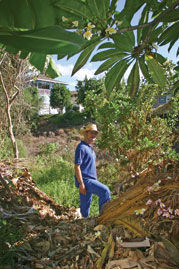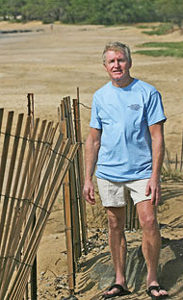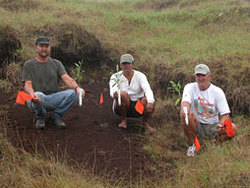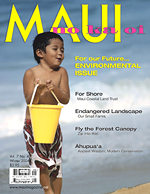|
M
A U I S T Y
L E
Environmental Heroes
by Helen
Gillette
Through the years, the natural environment of these Islands has
endured much.
Thankfully however, Maui is blessed with lots of public-spirited
volunteers who are out there doing what they can to make a
difference. Whether it’s reforesting, recycling, or protecting our
endangered species, these folks are saving and preserving our
environment one tree, one turtle, one landfill at a time. We’ve
selected just a very few to honor here.
With a Computer and Shovel
Photo: Ron
Dahlquist
 In a scrubby gulch of a Kihei subdivision, two blocks from his
home, Lee Altenberg is busy planting a forest. In a scrubby gulch of a Kihei subdivision, two blocks from his
home, Lee Altenberg is busy planting a forest.
This gulch, running from the 5,000-foot level of Haleakala to the
Kama‘ole beaches, was once filled with native forest, most of
which was long ago trampled and eaten by cattle, and crowded out
by invasive species.
For about three years, Altenberg, a computer science professor
with the University of Hawai‘i, has been rooting out the
intruders, what he calls “all those Walmart weeds,” while
nurturing the few remaining natives, and planting new ones—already
more than 20 species that once thrived in this area.
Altenberg takes the cuttings and seeds from plants like naio,
koai‘e, wili wili, ‘a‘ali‘i and ‘ohai growing in the Palauea Beach
area south of Wailea, where planned development will further eat
into the remnants of the dry land forest there. He tries to
propagate the cuttings and seeds in his little backyard nursery.
When they’re sturdy enough, he transplants them at the gulch,
regularly returning to water and nurture them.
Through the years, Altenberg has been a working volunteer on a
number of reforesting projects, including the forest remnants at
Auwahi and Pu‘u O Kali, high on the flanks of Haleakala.
Along with shovel and hoe, Altenberg also uses the computer to
help save the native flora. His work with the university involves
investigating the theoretical foundations of evolution and
evolutionary processes. He says he went into this complex branch
of computer science because of its promise for making discoveries
that could help the world’s living conditions.
“As a kid I wanted to use computers to save the ecology, Altenberg
says.
“Now I just think that maybe we should try to do it one backyard
at a time.”
It would make a difference, he says, if neighbors started putting
native plants in their yards.
And if you want to help out in the gulches, Altenberg says “you’re
welcome to join ‘Lee’s Gym.’ Just come on over, and I’ll hand you
a pick.” You can call him at 875-0745.
Aloha Shares
“One Man’s Trash”
Joy Webster’s husband, architect Jim Hestand, used to come home
telling her about all the good, usable items he saw being hauled
to the landfill—lumber, light fixtures, furniture, fancy
appliances—items left over from building and remodeling projects.
Webster attacked the situation. Working through the Maui Recycling
Group, (she edits its quarterly Recycling Guide), Webster spent
months organizing a database of willing “donors” and nonprofits.
The effort is called “AlohaShares.”
“The aim,” she says, “is to keep usable materials out of Hawai‘i
landfills, and get them into the hands of our nonprofits, churches
and schools.” Nonprofits post their wish lists online at
www.alohashares.org. A business or individual with items to give
away posts lists of “give-aways,” and nonprofits consult the web
address to see what’s available.
The process is handled almost entirely by email. The first
nonprofit responding gets the item. The cost: nothing. There’s no
charge to anybody. Alohashares expenses are carried by the Maui
Recycling Group, which is not funded by the county. Expenses are
paid from grants, when they are available. Volunteers work without
pay. Any group or individual may join the donor group. Recipients
must be nonprofit organizations, churches or schools registered in
this state.
Toll-free: 1-866-542-2232 or www.alohashares.org
Labor of Love
Down in the Kanaha Beach dunes, just off the Kahului Airport
runways, almost every morning you’ll find this big bear of a man
busy tending what he calls his “17-acre garden.”
For months now, retired Lahaina postmaster John “Mike” Perry has
been ridding the beach area of what he calls “scrubby, ugly
invasive plants” so that the “small remaining islands” of native
Hawaiian plants can spread.
He says that he finds that if he just eliminates the
Johnny-come-lately
stuff, the good heritage plants will gradually recover and expand.
“It’s a lot less work than transplanting tender little greenhouse
plants, and it works better.”
The beach area from the Kahului Wastewater treatment plant to the
airport’s edge already looks much better, with pretty little
pink-flowered naio and others spreading over the dunes.
A year ago Perry had already put in so many volunteer hours that
the county, under its Retired Senior Volunteer program gave him
its annual Tony Tomoso “Outstanding Volunteer” Award for 2002.
He’d chalked up over 1,100 hours that year alone. U.S. Geological
Survey botanist Forest Starr said the Kanaha restoration project
is especially significant because the area contains some of the
Islands’ last undeveloped coastal dunes.
Clearly, this is a labor of love for Perry. Not only does he not
get paid, he seems to be putting his own money into the project.
Perry never says no to volunteer help, so go on down and hunt him
up. Call him at 572-9836.
Honu 'Ohana
Photo: Ron Dahlquist
 Everybody's
heard that our Hawaiian sea turtles need help. Of all the
hatchlings that crawl out of the nest, only about one in a
thousand makes it to maturity. There are lots of predators
out there, both on the beach and in the ocean. Everybody's
heard that our Hawaiian sea turtles need help. Of all the
hatchlings that crawl out of the nest, only about one in a
thousand makes it to maturity. There are lots of predators
out there, both on the beach and in the ocean.
Happily, the turtles have
some devoted human friends, a bunch of dedicated volunteers to
watch over them.
For instance, there's Maui
dentist Steven Williams. For the past seven years he has
coordinated the Turtle Dawn Patrol on the beaches from Ma'alaea to
Big Beach, taking turns with this band of 30-some volunteers -
among them, his wife, Esten, and their two daughters.
Early nearly every morning
during the June to October nesting season, they're out looking for
new turtle tracks, trying to locate freshly made nests.
After consulting with biologists, the volunteers mark the nesting
areas and then watch over them until hatching day.
Afterwards, they carefully excavate the vacated nest to count
eggshells and free any keiki who couldn't dig their way out.
Getting on with L.I.F.E.
Photo: Bill Korey
 When Walter Kanamu goes hiking alone in the forest, he says he
feels his grandfather’s spirit hovering near, sometimes
whispering, “Save the forest.” When Walter Kanamu goes hiking alone in the forest, he says he
feels his grandfather’s spirit hovering near, sometimes
whispering, “Save the forest.”
Kanamu’s grandfather, William Kai‘aokamalie, would be just the
type to pass on that message. About 1939, he met visiting
botanist-explorer Joseph Rock during Rock’s second trip to Maui,
and took him around the island to see what was left of the
vanishing dryland forests. Rock, aghast at the destruction, urged
the Hawaiian man to do what he could to preserve the remains of
forests that had once covered the mountainsides.
When Kai‘aokamalie was a kid, ‘Ulupalakua was all canopied
forest. But he lived to see vast areas cut back for family farms,
ranches and sugar cane.
What was left was being encroached upon by animals and invasive
plants.
Kai‘aokamalie took Rock seriously and started fencing in Auwahi,
a forest fragment located on the outskirts of ‘Ulupalakua Ranch.
“I was just a young kid then,” Kanamu says, “but I remember. He
took my dad, my uncle and me into the forest”.
Kanamu, a Maui Community Corrections Center employee, says that,
in 1996, the old fence was still there, rusty and ready to fall
down, when U.S. Geological Survey’s research biologist Art
Medeiros was directing a band of volunteers in re-fencing Auwahi.
Kanamu and his cousins, Wally English and Ma=healani
Kai‘aokamalie worked with them.
“In 1995, my cousins and I established the first Hawaiian
nonprofit environmental organization: Living Indigenous Forest
Eco-Systems,” Kanamu says. And so began L.I.F.E.
Another cousin, Aiona Kai‘aokamalie, whom Kanamu says was the
“inspiration” for setting up L.I.F.E., had already passed away.
Now L.I.F.E. is concentrating on the forests on Hawaiian Homestead
Lands located high up on a slope of Haleakala. The organization
is headed by the three cousins.
Using $100,000 made available by the U.S. Fish and Wildlife
Service for fencing and helicopter time, they’re putting in seven
miles of fence, from the area adjacent to Poli Poli and above
Kanaio to Manawainui Gulch, in order to keep out cattle, goats,
wild pigs and deer.
Lots remains to be done, Kanamu says, but they’re on their way.
To learn how you can help call Walter at 760-8224.
Friends of Keone‘o‘io
Down at La Pérouse Bay, you’re apt to see someone running around,
clipboard in hand, talking to people who are out picknicking,
kayaking and otherwise enjoying that remote bit of shoreline.
That person is likely to be one of the volunteers of the Friends
of
Keone‘o‘io, an organization set up in 1999 to protect that area
so rich in archeological treasures.
For four years the volunteers have been stationing themselves at
the beach, collecting human use data, handing out brochures
encouraging wise stewardship of the area, and doing all they can
to cordially educate people about the impact to this endangered
area from increased traffic by hikers, kayakers, snorkelers and
others.
It’s hot, dusty (unpaid) work, but worthwhile, say the volunteers,
now 100 strong. Others agree that the friends are doing good work.
The grassroots group has received several grants to fund
educational brochures and a Web site.
On most days you’all find one or more of the volunteers at an
information table near the beach spreading the word about the
historical and environmental richness of the bay. You can find out
more about the Friends of Keone‘o‘io by calling 808-870-6957.
|

